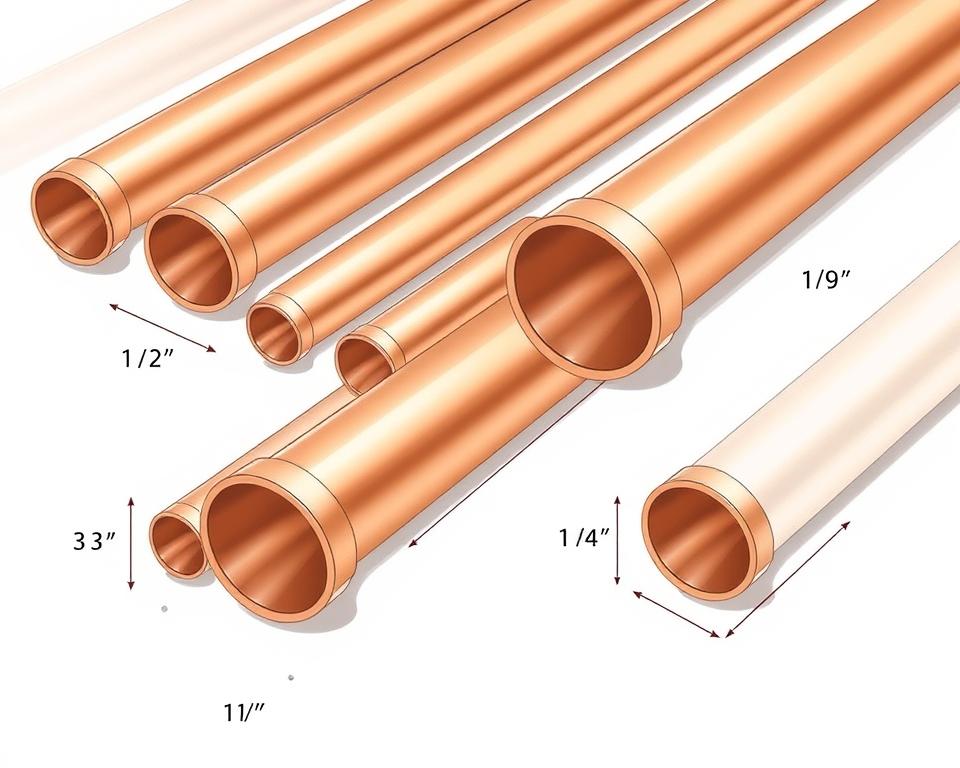Your Guide to Copper Water Line Sizing at Home
It may surprise you that approximately 30% of residential plumbing failures come from improper pipe sizing. Using the proper dimensions helps maintain ideal water pressure and system efficiency. Here’s a homeowner’s primer on the sizing essentials for residential water projects.
Proper sizing depends on factors like flow requirements and wall thickness. Industry-standard 5/8 copper pipe spans diameters from 1/4″ up to 8″, indicated by NPS (Nominal Pipe Size) versus true OD. Installation Parts Supply provides professional advice to align your home requirements with code-compliant options.
Thanks to its toughness and rust-resistance, copper is still preferred. From system upgrades to fresh installations, grasping these basics conserves time and wards off expensive errors.
Key Learnings

- Proper sizing averts 30% of typical plumbing failures
- Standard diameters range from 1/4″ to 8″
- Nominal Pipe Size isn’t the same as true OD
- Proper sizing maintains water pressure and efficiency
- Copper offers durability and corrosion resistance
- Specialist support secures regulation adherence
Why Choose Copper Pipes for Your Plumbing System?
Plumbing longevity starts with selecting the right material—here’s why copper stands out. Boasting a half-century lifespan and NSF potable-water approval, it’s a go-to for residences. It uniquely blends durability with environmental responsibility.
Toughness and Rust Protection
Resisting rust and chemicals by nature, copper outlasts PVC and PEX. Smooth bore reduces friction, keeping water pressure steady. Real-world examples show installations lasting decades without leaks.
Find certified, high-grade selections at Installation Parts Supply for your requirements. While initial costs are higher, the long-term savings from fewer repairs justify the investment.
Bendability and Freeze Safety
In chilly regions, copper expands just enough when freezing to avoid splits. This give lowers the likelihood of pricey cold-weather failures. Pair it with proper insulation for maximum freeze protection.
Eco-Friendly and Antimicrobial Benefits
Being wholly recyclable, it cuts environmental burden. Its antimicrobial properties inhibit bacteria growth, enhancing water safety. Environmentally minded users find it superior to plastic substitutes.
Understanding Copper Pipe Water Line Sizes and Types
Many homeowners struggle with pipe sizes—let’s break it down. Industry NPS labels don’t correspond to real outside measurements. As an instance, 1/2″ NPS measures 0.625″ across externally.
Nominal vs. Actual Pipe Dimensions
NPS numbers are labels, not exact measurements. Verify the OD itself when buying. A conversion chart helps:
- 1/4″ NPS = 0.375″ OD
- 1/2″ NPS corresponds to 0.625″ OD
- 3/4″ NPS = 0.875″ OD
Comparing Types L, M & K
Three types copper dominate residential plumbing. Their wall thickness determines strength and use cases:
- Type L: Light gauge (0.040″ @ 1/2″), perfect for standard homes.
- Type M: Medium-wall (0.050″ for 1/2″), balances cost and durability.
- Type K: Heavy-wall (0.060″ for 1/2″), for high-pressure systems.
Type M is suggested by Installation Parts Supply for broad residential use. Larger diameters (over 2″) often require Type K for irrigation or commercial use.
Type L Copper Pipes: Thin-Wall Versatility
For homeowners tackling DIY projects, L-type offers unmatched flexibility. Thin gauge lightens load and price yet stays robust. Comes both in straight bars and flexible coils for HVAC to DWV work.
Where L-Type Excels and Falls Short
It’s perfect for low-PSI situations. With 0.040″ walls, it’s great for:
- HVAC refrigerant lines
- Drain-waste-vent (DWV) systems
- Residential water supply (below 80 PSI)
High-pressure? Skip L-type and choose K-type instead. Soft coils (up to 50ft) simplify bending around obstacles but require careful handling to prevent kinks.
Sizing Options and Installation Tips
Sizes span 1/4″–8″, including:
| Form | Max Length | Best For |
|---|---|---|
| Rigid | 20ft | Straight runs |
| Coiled | 50ft | Tight spaces |
Beginners will find rigid lengths, as recommended by Installation Parts Supply, the easiest to cut and solder. When tackling big installations, coils mean fewer joints, saving time and leak hazards.
M-Type Copper Pipes: The Homeowner’s Choice
Balancing cost and performance, M-type emerges as the top pick for modern homes. Its medium-wall design handles everyday demands while keeping budgets in check. NSF-certified for potable water and gas lines, it’s a safe choice for kitchens, bathrooms, and heating systems.
Ideal Uses for M-Type
This type excels in hot and cold supply lines, maintaining steady water pressure. Use 12ft rigid for long stretches, 100ft coils for narrow pathways. Popular applications are:
- Drinking water distribution
- Medical gas lines (oxygen, nitrous oxide)
- HVAC refrigerant lines
M-Type Gauge & PSI Ratings
M-type strikes a balance between L and K types. With 0.050″ walls, it tolerates up to 150 PSI without failure. See the specs contrast:
| Type | Wall Thickness (1/2″) | Max Pressure | Best For |
|---|---|---|---|
| L | 0.040″ | 80 PSI | Low-pressure DWV |
| M | 0.050″ | 150 PSI | Residential supply |
| K | 0.060″ | 200 PSI | Irrigation |
Installation Parts Supply keeps M-type stocked across standard diameters. Combine with proper flare connectors for gas lines to secure seals. Leave small expansion joints in hot lines for temperature shifts.
Type K Copper Pipes: Heavy-Duty Performance
For ultimate robustness, choose K-type in rigorous settings. Heavy walls plus high PSI capacity suit it to industrial or buried lines. Unlike thinner alternatives, it resists crushing and corrosion in harsh environments.
K-Type for High PSI & Irrigation
K-type excels where others fail. With 0.060″ walls, it tolerates 200 PSI, suitable for:
- Underground irrigation systems
- Commercial HVAC refrigerant lines
- Fire sprinkler networks
Installation Parts Supply advises an 18″ burial depth for underground runs. Combine with compression fittings torqued at 25 ft·lb to ensure leak-free performance.
How to Choose Rigid or Coiled K-Type
Pick rigid or coil depending on application. Rigid 12ft sticks suit straight runs, while 50ft coils navigate obstacles. Here’s how they stack up:
| Form | Best For | Limitations |
|---|---|---|
| Rigid | High-pressure mains | Requires more fittings |
| Coiled | Trenchless installations | Risk of kinks if bent sharply |
Plan irrigation loops with 10% extra length for expansion. Avoid bending rigid forms without a tube bender—kinks reduce flow efficiency.
Installing and Caring for Copper Pipes
Proper installation techniques ensure decades of leak-free performance in plumbing systems. Homeowners and contractors both gain by learning these key steps. Implement these tips for reliable, enduring installations.
Connection Options Compared
Choose the right technique based on your project’s needs. Use solder or compression for lasting joins; temporary fittings for flexibility. See which suits you best:
| Method | Pros | Cons | Best For |
|---|---|---|---|
| Soldering | Strong, permanent | Requires skill | Water supply lines |
| Compression | No heat needed | Bulky fittings | Tight spaces |
| Push-Fit | Quick installation | Higher cost | Emergency repairs |
How to Solder Copper Pipes
Achieve a perfect joint by doing this:
- Use emery cloth to clean both surfaces.
- Coat each piece evenly with flux.
- Apply torch heat until you hear the flux hiss.
- Apply solder to the seam; it will wick in automatically.
Always wear heat-resistant gloves and work in a ventilated area. Installation Parts Supply stocks lead-free solder for drinking water safety.
Leak Prevention & Freeze Protection
Wrap pipes in unheated zones with foam sleeves. Fit foam sleeves where lines pass exterior walls. For repair tips:
- Look for greenish corrosion at joints each year.
- Support horizontal runs every 32 inches to prevent sagging.
- Choose freeze-safe taps in winter-prone areas.
Yearly checks spot small problems early. Have essential tools on hand—wrenches, cutters, Teflon tape handle most jobs.
Final Thoughts on Copper Pipe Selection
A thoughtfully designed plumbing network endures for years—here are the main points. Pick the correct gauge and diameter to maximize durability. Keep in mind:
- M-type works for most residences; K fits heavy-duty applications
- Proper sizing maintains pressure and prevents leaks
- Preventing pipe freeze is vital in chilly regions
Get specialist advice from Installation Parts Supply to streamline decisions. Their certified products come with quality guarantees, ensuring your plumbing systems perform flawlessly.
For support, grab our free guides or arrange a consultation right away. First-time buyers get exclusive discounts—start your project right!


